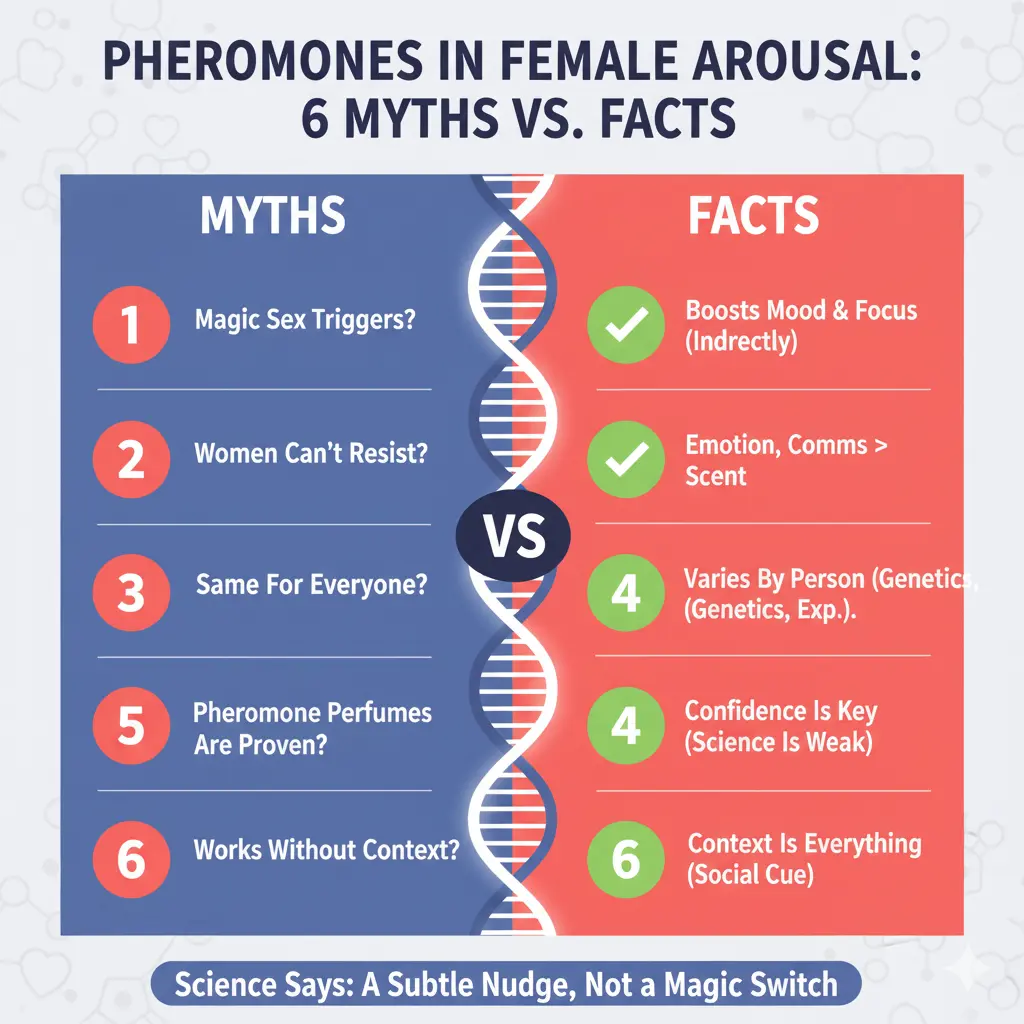The Invisible Force We’re All Curious About
Have you ever walked past someone and felt instantly drawn to them — not because of how they looked or what they said, but something you couldn’t quite explain? Yeah, me too. Many people chalk that up to pheromones — those invisible chemical messengers that supposedly play a huge role in attraction.
But here’s the real question: Do pheromones actually influence female arousal, or is it just another sexy myth marketers love to sell?
I’ve lost count of how many “pheromone perfumes” I’ve seen on shelves promising to make you irresistible. Honestly, I’ve even tested one out for fun (spoiler: nobody threw themselves at me in the supermarket aisle). But the science isn’t as simple as the marketing makes it sound.
Today, let’s break it down together: the role of pheromones in female arousal myths vs facts. We’ll sift through the hype, talk about what research actually shows, and figure out how much of this is biology versus psychology.
Table of Content
What Are Pheromones Anyway?
Pheromones are chemical signals released by our bodies that can trigger social or sexual responses in others. In animals, they’re crystal clear. A female moth releases pheromones, and suddenly a male moth miles away is fluttering toward her like she’s the only one on Earth.
But humans? We’re a lot messier. Unlike moths or dogs, we don’t rely on pheromones alone to choose a mate. We’ve got personalities, conversations, shared values, and yes, even that weird thing called “vibe.”
Scientists have found compounds like androstadienone in male sweat that women can detect, though some of us are more sensitive than others. According to a study published in NCBI, women exposed to this compound experienced improved mood and focus, which indirectly could enhance sexual arousal. Still, that’s very different from saying pheromones are the main driver of desire. In fact, when it comes to the role of pheromones in female arousal myths vs facts, the evidence shows they play a subtle supporting role rather than being a magic switch for attraction.
The Big Myths About Pheromones and Female Arousal
Let’s clear up some of the most common myths about the role of pheromones in female arousal myths vs facts.
Myth 1: Pheromones are magic sex triggers
The classic belief is that pheromones instantly make someone attracted to you. If that were true, pheromone sprays would sell out every day, and dating apps would go extinct.
Fact: Research shows pheromones might influence mood and perception, but they don’t override free will. Attraction is still a cocktail of psychology, context, hormones, and personal taste. As the American Psychological Association points out, pheromone effects in humans are far more subtle than in animals.
Myth 2: Women can’t resist pheromones
Ever heard, “If a man wears pheromones, women won’t be able to say no”? That’s both misleading and dangerous.
Fact: Attraction is multi-layered. Smell might play a role, but factors like emotional connection, communication, and even stress levels matter way more. For example, communication styles strongly affect arousal in women, showing that emotional intimacy often outweighs scent alone.
Myth 3: Pheromones are the same for everyone
Marketers love selling “one-size-fits-all” pheromone products.
Fact: Sensitivity varies. Some women pick up on androstadienone easily, while others barely notice it. Genetics, personal experiences, and even cultural differences can change how pheromones are perceived. This is why the role of pheromones in female arousal myths vs facts often comes down to individual differences rather than universal truths.
Myth 4: Pheromones are stronger than hormones
It’s tempting to believe pheromones are the ultimate driver of desire.
Fact: Hormones play a much bigger role in shaping female sexual response. As explored in this guide on how hormones affect female sexual desire, shifts in estrogen, progesterone, and testosterone levels have a direct impact on libido. Pheromones may enhance the experience, but hormones are the real powerhouse.
Myth 5: Pheromone perfumes are scientifically proven
We’ve all seen products promising to make you “instantly irresistible” thanks to pheromones.
Fact: The evidence behind pheromone perfumes is weak. A review from ScienceDirect notes that while some studies suggest pheromones affect human behavior, most results are inconsistent and influenced by context. The truth is, wearing a fragrance you love can boost your confidence — and confidence is often sexier than any chemical compound.
Myth 6: Pheromones work without context
Some people believe pheromones have the same effect regardless of the situation.
Fact: Context is everything. In one study, women exposed to androstadienone reported improved mood — but only when a male experimenter was present. Without the social context, the pheromone effect disappeared (see study here). This shows that human attraction is never just chemical — it’s deeply social and psychological too.

What the Science Actually Says
Okay, let’s get real with some actual research, because the role of pheromones in female arousal myths vs facts isn’t just about stories and perfume ads. Science has a lot to say, even if the answers aren’t crystal clear.
Androstadienone and Female Response
One of the most studied compounds is androstadienone, found in male sweat. According to research published in NCBI, exposure to this chemical has been linked to improved mood and sharper attention in women, especially in social or romantic contexts. And here’s the interesting part: better mood and heightened focus can indirectly enhance sexual response. But that doesn’t mean it’s a direct “turn-on switch.”
Pheromones and Mate Selection
Studies also suggest pheromones may play a role in mate selection, particularly when it comes to immune system compatibility. Ever heard of being attracted to someone just because they “smell right”? There’s a scientific reason for that. Some research points to the idea that women may be more drawn to partners with different HLA genotypes, which could subconsciously signal a stronger potential for healthy offspring.
The Subtle “Nudge” Effect
According to a review in ScienceDirect, the evidence isn’t strong enough to claim pheromones directly cause arousal. Instead, they may work more like gentle nudges that shift perception — making someone seem a bit more appealing in the right context.
Hype vs Reality
The American Psychological Association has also weighed in, pointing out that results in pheromone research are murky. A lot of what we hear about pheromones actually comes from the beauty and fragrance industry, which benefits from the idea of a magical “love potion.”
So, Where Does That Leave Us?
Yes, pheromones exist. And yes, they may influence mood, focus, and how attractive someone seems. But they’re not love potions, and they definitely don’t override things like emotional connection, communication, or hormonal shifts. In other words, the science supports pheromones as a small piece of the puzzle — not the entire picture of female arousal.
Beyond Pheromones: Other Factors in Female Arousal

If we zoom out, female arousal isn’t just about one magical factor. The truth is, the role of pheromones in female arousal myths vs facts shows that pheromones are only a small part of a much bigger picture. Real desire is influenced by a mix of biology, psychology, and even life stage. Let’s break it down.
- Hormones: Hormones are the heavy lifters when it comes to arousal. Fluctuations in estrogen, testosterone, and progesterone can make libido skyrocket or dip. As explained in this guide on how hormones affect female sexual desire, hormonal balance has a direct impact on how easily a woman gets aroused, far more than pheromones ever could.
- Psychological State: Ever tried being intimate while stressed or anxious? It doesn’t work well. Stress, body image issues, and even simple distractions can dampen arousal — no matter how many pheromones are in the air. A relaxed, safe, and emotionally connected environment is often the real aphrodisiac.
- Physical Health: Your body plays a huge role in sexual response. Strengthening pelvic floor muscles through simple kegel exercises can improve blood flow and sensitivity, making arousal easier and more satisfying. Unlike pheromones, these changes are directly in your control.
- Life Stage: Perimenopause and menopause often bring changes in libido. While pheromones might nudge attraction slightly, hormonal shifts are much more powerful. The good news? There are natural ways to manage this. If you’re curious, check out this guide on how to maintain libido during perimenopause naturally.
- Type of Stimulation: Not all arousal feels the same, and not all women respond the same way. Some find clitoral stimulation essential, while others enjoy deeper vaginal arousal. To understand the difference, you can read more about clitoral vs vaginal arousal.
- The Bigger Picture: When you put all of these together, it’s clear that pheromones are just one piece of the puzzle. They might set the stage by improving mood or making someone seem more attractive, but hormones, health, emotions, and context are what truly drive female arousal.
Should You Buy Pheromone Products?
Let’s be real for a second — pheromone sprays, perfumes, or oils aren’t harmful. If they make you feel sexier or give your confidence a little boost, why not? Confidence is one of the most attractive qualities you can radiate. But here’s the catch: don’t expect a tiny bottle of pheromones to magically transform your sex life.
In my experience, the real spark doesn’t come from a spray. It comes from feeling good in your own skin, communicating openly with your partner, and setting the right mood. A gorgeous fragrance (whether pheromone-based or not) can definitely enhance the vibe — light a candle, wear a scent that makes you smile, maybe even experiment with a pheromone product if you’re curious. Just remember, it’s not the scent alone that seals the deal.
Myth-Busting With a Smile
So, what’s the role of pheromones in female arousal myths vs facts? Let’s break it down.
✨ Myths:
Pheromones are instant turn-ons.
They’re irresistible to everyone.
One spray guarantees sexual attraction.
✅ Facts:
Pheromones may influence mood, focus, and how attractive someone seems.
Arousal isn’t triggered by pheromones alone — it’s shaped by hormones, emotional connection, context, and physical stimulation.
Attraction is deeply personal, not universal.
At the end of the day, attraction is beautifully complex. Pheromones might play a small part in the chemistry, but they’re more like background music than the main act. They can set the mood, but the real melody of arousal comes from confidence, intimacy, and connection.
FAQs About Role of Pheromones in Female Arousal Myths vs Facts
Q1: Do pheromones really affect female arousal?
Yes, but indirectly. Research shows they can improve mood and focus, which can enhance arousal. They don’t act like instant attraction switches.
Q2: Are pheromone perfumes effective?
They may boost confidence, but scientific evidence for direct arousal is weak. The role of pheromones in female arousal myths vs facts shows more psychology than chemistry.
Q3: Why do some scents make women feel more attracted to certain men?
Partly pheromones, partly natural scent, and partly individual preference. Attraction is subjective.
Q4: Can pheromones replace emotional connection?
Not at all. Communication, trust, and emotional intimacy play a far bigger role in arousal.
Q5: Are pheromones more powerful than hormones in arousal?
No. Hormones influence female sexual desire much more directly. Pheromones are subtle mood enhancers at best.




